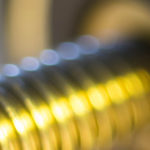Worm-screw jacks are a linear-motion design that’s been around for decades — though the modern version of the screw jack has changed a lot since its inception in the 1940s. Today’s versions use a basic worm-gear mechanism to drive either an acme screw or ball screw.
When is a worm-screw jack a suitable linear-motion solution?
Anytime an engineers needs vertical linear motion to raise very heavy loads of many tons, and where speed is not the main objective — especially when some type of gear reduction is needed. Typical applications are lift platforms, work stands, and gates. Often, worm screw jacks see loads as much as 50, 75, or 100 tons.
One advantage of a worm screw jack is the ability to link them together. Many design engineers consider screw jacks for use in their applications, as they have a unique ability to be linked together using shafting and miter boxes using a single common motor. Worm screw jacks have a single worm shaft accessible from both sides of the jack housing, and therefore you can mount a motor on one side and couple to an adjacent jack on the other side. However, there are some caveats when considering a worm-screw jack.
Worm screw jacks are tough mechanical devices made from ductile cast-iron- housings, so handle some difficult applications …
.. but because there is a linear screw protruding from the gearbox, they are typically grease filled rather than oil filled. So such jacks can’t cool as well as other designs — and that can limit duty cycle. With many applications, this isn’t an issue, because continuous duty isn’t always required. A lift platform may lift once or twice a day, for example. In contrast, applications needing aggressive duty cycles may prompt selection of jacks larger then what engineers might expect.
In a video we shot last year at the Design World offices, a Nook Industries representative chatted with us about some of these design considerations and the fundamental operation of worm-screw jacks. Also in this video are details on lift platforms, work stands, and gates or values — and typical loads in tons that jacks often see.







Leave a Reply
You must be logged in to post a comment.